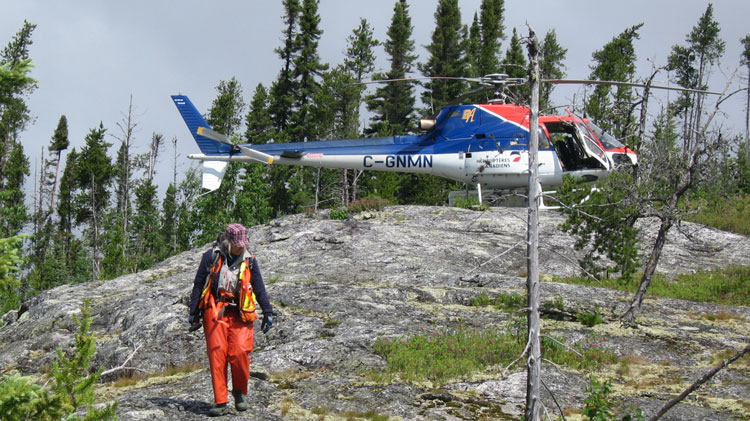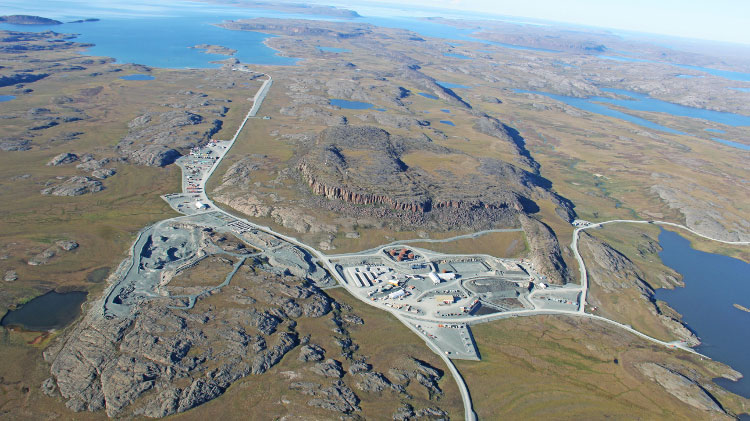A scow en route from Athabasca Landing to McMurray, 1914 (CIM Bulletin, 1947).
The oil sands deposits in northeastern Alberta contain the fourth-largest proven oil reserves in the world, after Venezuela, Saudi Arabia and Iran. The oil sands deposits, which account for more than 95 per cent of Canada’s oil reserves, have three main areas—the Athabasca, Peace River and Cold Lake deposits.
The province’s oil sands first came to the attention of Europeans in the 18th century, but it would be more than two centuries before bitumen would be successfully extracted from them. “Early explorers and fur traders such as Peter Pond, [Alexander] MacKenzie and others, noted the ‘pitch’ saturated sands along the Athabasca River in the vicinity of the junction of the Clearwater with that river in their journals,” wrote W.B. Gallup (CIM Bulletin, April 1960). “R. G. McConnell in his surveys of the Athabasca River for the Geological Survey of Canada in 1892 and 1893 identified the sequence, and described it, as the McMurray formation.”
In the late 19th and early 20th centuries, various private speculators were drawn to the region to drill for oil, many expecting the deposits to be conventional oil reservoirs.
Development attempts
In 1913, a comprehensive investigation into the oil sands was begun by the Mines Branch, Department of Mines, led by Sidney Ells; his research was interrupted during World War One but resumed in 1920. He mapped the distribution of the bituminous beds in outcrop, did extensive samplings and offered an analysis of the extraction problem with respect to mining and separation. “Bituminous sand consists, for the most part, of clear quartz grains, cemented together by petroleum residuum or bitumen. In form the quartz grains are most irregular, varying from sharply angular to smooth, waterworn shapes,” wrote Ells (CIM Bulletin, 1925).
Ells demonstrated that bitumen could potentially be extracted from the oil sands using hot water, and he was a proponent of using it as “a surfacing material for streets and highways, for sidewalks, railroad platforms, machine shops, stockyards and other surfaces where cleanliness and wearing properties are essential.”
In the 1920s, Karl Clark from the Scientific and Industrial Research Council of Alberta built on Ells’ work, and he noted some of the practical problems of hot water separation. “The separation of the bitumen from bituminous sand by the use of hot water is a problem in colloid chemistry,” he wrote (CIM Bulletin, 1929). “Bituminous sand is a colloid system, and the resolution of it into its constituent parts in a medium of water depends on the proper manipulation of the factors which dominate in the behaviour of matter in the colloid state.”
Clark developed a hot water separation process, patented in 1929, which mixed the oil sands with hot water and used caustic soda (sodium hydroxide) as a softening agent. This method later became the basis for successful commercial oil sands extraction operations.
Several pilot oil sands separation plants were developed in the following decades, but they faced problems in effectively separating the bitumen from the sand and few progressed beyond the laboratory stage.
Clark (CIM Bulletin, 1944) highlighted the Research Council of Alberta’s pilot plant, which was built and operated on the Clearwater River near Waterways during 1929 and 1930, and the Abasand Oils plant in Horse River Valley. “There are two main principles for clean separation of oil from bituminous sand,” he explained. “The first is that the oil should be displaced from the sand grains by the use of a minimum of water. The second principle is that the oil, after being displaced from the sand surfaces, should be got into the form of oil froth with the use of a minimum of air.
“The sizable separation plants that have been erected and operated so far have been satisfactory from the standpoint of oil recovery but have failed in the matter of low sand content of recovered oil.”
Full-scale production
Great Canadian Oil Sands Limited, a company formed by Sunoco in 1952, which later became Suncor Energy in 1979, received the first permit to build a full-scale industrial oil sands separation plant in the Alberta oil sands. This large-scale surface mining and bitumen-refining operation opened in September 1967.
“Rapid developments in earth-moving equipment have extended the potential use of mining techniques from 3 to 20 per cent of the total oil sand deposit,” wrote B.D. Sparks, F.W. Meadus and I.E. Puddington (CIM Bulletin, June 1971).
Another permit was granted to the Syncrude consortium in 1973, and the second full-scale oil sands project opened at Mildred Lake in September 1978. “After an expenditure of approximately $2.26 billion, the second and the largest commercial tarsands plant was on stream toward a permit production rate of 129,400 barrels of synthetic crude oil per day,” wrote J.E.C. Carter and Y.P. Malhotra (CIM Bulletin, March 1983). “The Syncrude Plant, a joint venture of six oil companies, the federal government and the Alberta government, is a major step forward toward the goal of Canadian energy self-sufficiency.”
Carter and Malhotra described the mining process at Mildred Lake, which consisted of waste removal mainly with hydraulic shovels, mining and windrowing of oil sands with draglines, and the reclaiming of the windrows with bucket-wheel excavators and conveyor systems. “The mine conveyors deliver tar-sand to the extraction plant, where the bitumen and the sand are separated by hot water treatment. The clean sand is then delivered to the tailings area. The bitumen is diluted with naphtha to reduce its viscosity and passed through centrifuges to remove the remaining water and fines,” they wrote.
In-situ approaches
However, not all of the oil sands are suitable for surface mining. “The surface mining technique, which is being used by Syncrude and Suncor to produce almost 200,000 barrels/day of synthetic crude, is economically practical where the overburden is less than about 75 metres thick,” wrote J.C. O’Rourke and J.A. Haston (CIM Bulletin, January 1989). “Surface-mineable deposits account for roughly 7% of the areal extent of the Athabasca oil sands. Clearly, other techniques, the so called in-situ processes, need to be developed to access the rest of the resource.”
The Alberta Oil Sands Technology and Research Authority (AOSTRA) was formed by the Alberta government in 1974 to promote the development of new technologies for oil sands and heavy-oil production. It received funding in 1983 to build an Underground Test Facility (UTF), which it opened in 1987. “The facility initially is to serve as an underground laboratory from which to field test new approaches to in-situ recovery of the bitumen (oil) in the Athabasca deposit,” wrote O’Rourke and Haston.
J.A. Haston, R.W. Luhning and S.D. Gittins (CIM Bulletin, June 1990) wrote that the UTF project had achieved “marked success in field testing mining access and horizontal well in-situ recovery of bitumen,” adding that “In-situ recovery of bitumen from the Athabasca deposit has been recognized for many years as one of the most difficult challenges in heavy oil development, and the UTF project is clearly demonstrating technical breakthroughs in this field.”
They noted that mine access has provided for effective placing and operation of horizontal wells in the oil sands from a tunnel system in the underlying limestone. “Performance of the in-situ recovery process, steam assisted gravity drainage [SAGD], has substantially exceeded forecasts made at the start of the project,” they wrote. “Overall results of the program to date show great promise for horizontal well in-situ technology as a competitive source of bitumen from Alberta’s vast oil sands deposits.”
Various in-situ pilot plants went into operation in the 1990s, and the first large-scale commercial SAGD facility was launched at Foster Creek in 2001. According to the Alberta government, in 2012, the province’s in-situ production surpassed its mined oil sands production for the first time; and in 2022, crude bitumen production from the oil sands (including both surface mines and in-situ extraction) totalled approximately 3.3 million barrels per day (bpd).




